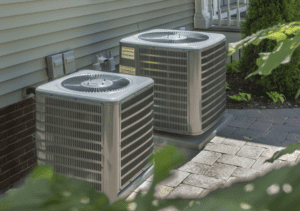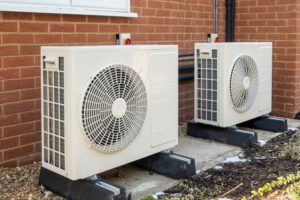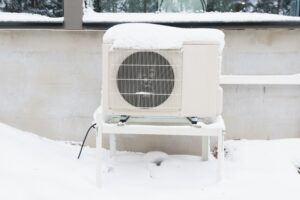An ideal modern home design for wintertime is a cozy fireplace. A fireplace is a classy addition to any living room and is often a center for family gatherings and making memories over the holiday season. It’s no surprise because who doesn’t love sitting on a comfy chair near the fire, watching the flames crackle, and warming their toes on the hearth?
But one question that homeowners should ask when preparing the winter fireplace is: How will this affect my air quality?
A fireplace can be a delight but also a source of harmful smoke, carbon monoxide, and lost HVAC dollars if managed without care. This begs us to ask: Should you turn off your central heat when using the fireplace? How can you keep your home heating efficient while enjoying cozy fires? And Is it safe to leave the fireplace open?
We’re here to answer all your essential questions and reveal the best ways to enjoy both fires and central heat in the winter.
Should I Turn Off My Central Heat When Using My Fireplace?
The short answer is no. Leaving your central heat on when you light a fire in the fireplace is the most effective way to ensure your home stays warm, and actually, both central heat and fireplaces can work together to create heat and keep the house warm.
Central heat generates heat inside an appliance unit and runs air past it. It then pushes the heated air throughout the house, keeping every room warm based on the thermostat in the center. The thermostat tries to keep the house at a set temperature and ideally will switch off when the house is warm enough.
When you light a fire in an indoor fireplace, most of the heat is carried up and out the flue – which should always be open when fires are lit. While opening the flue is essential for directing noxious gases away from your indoor atmosphere, it does mean that you only get 10-20% of the heat generated from the flames. This makes your fireplace more compatible with your HVAC but is ineffective at lowering your heating bills.
Turning off your heat also means the rooms far away from the fireplace will often get too cold and will be less efficient when you turn it back on.
How Can I Use My Central Heat Efficiently with My Fireplace?
The good news is when used correctly, and in conjunction with your indoor air and heating, a fireplace can complement your heating capabilities while remaining a family favorite. To use your central heat effectively and efficiently with your fireplace, you should:
- Close the glass fireplace doors
- Keep the flue open during fires and closed when there is no fire lit
- Annual chimney inspection and repair
- Switch heat to ‘auto’ when lighting a fire
- Regularly replace air filters and keep up with HVAC maintenance
Following these steps can create a perfect recipe for efficient central heating while using a fireplace, especially when you keep up with these five healthy fireplace practices:
-
Keep Your Fireplace and Chimney in Good Repair
A damaged or cracked chimney is bad for HVAC efficiency because outdoor and indoor air escape where they are not supposed to. Likewise, a damaged fireplace and chimney system can cause air quality problems if a backdraft of smoke or carbon monoxide enters the house.
-
Close the Flue When Fires are Not Lit
Flue management is vital. Always have the flue open when you light fires, but remember to close the flue when the fire is done. Never allow the flue to stand open without a fire, as this will lose heat from your central air and cost more. However, the flue must be open when there’s a fire to let smoke and other fumes leave the home safely.
-
Switch Your Heat to “Auto” During Fire Time
You don’t need to switch off your central heat to light a fire and, in fact, likely shouldn’t. But you should set your heat to “auto.” This allows the heater to choose when and how much to run to maintain a comfortable home temperature. If the fireplace adds warmth to the house, your heater will give it some time to be glowy-warm before pumping more heat into the rooms.
-
Close the Glass Fireplace Doors for a Long Burn
If you are basking by the fire, opening the glass fireplace doors can be pleasant and allow fireplace family favorites such as roasting S’mores! However, for a longer burn, close the glass doors and let the heat gently radiate through the glass. This helps to maintain better home air quality and keeps heat distribution more even from central heating in your home.
-
Change the Air Filter Regularly
Fireplaces add a small amount of soot and other air pollution to your home air, which taxes your HVAC air filter more heavily. Be sure to change your air filter at least once a month in the winter to compensate for the smoke from cozy fires.
Regular Maintenance for HVAC Systems
Regular care is one of the best things you can do if you have a fireplace and central air for your home’s air quality and HVAC power efficiency. A routine maintenance check ensures that your home is safe and that your central heat performs well when you need it most – all winter long. Cates Heating & Cooling provides reliable HVAC service plans and a complete protection service package that can keep your family cozy and with good air quality all year, with or without a fireplace.



















